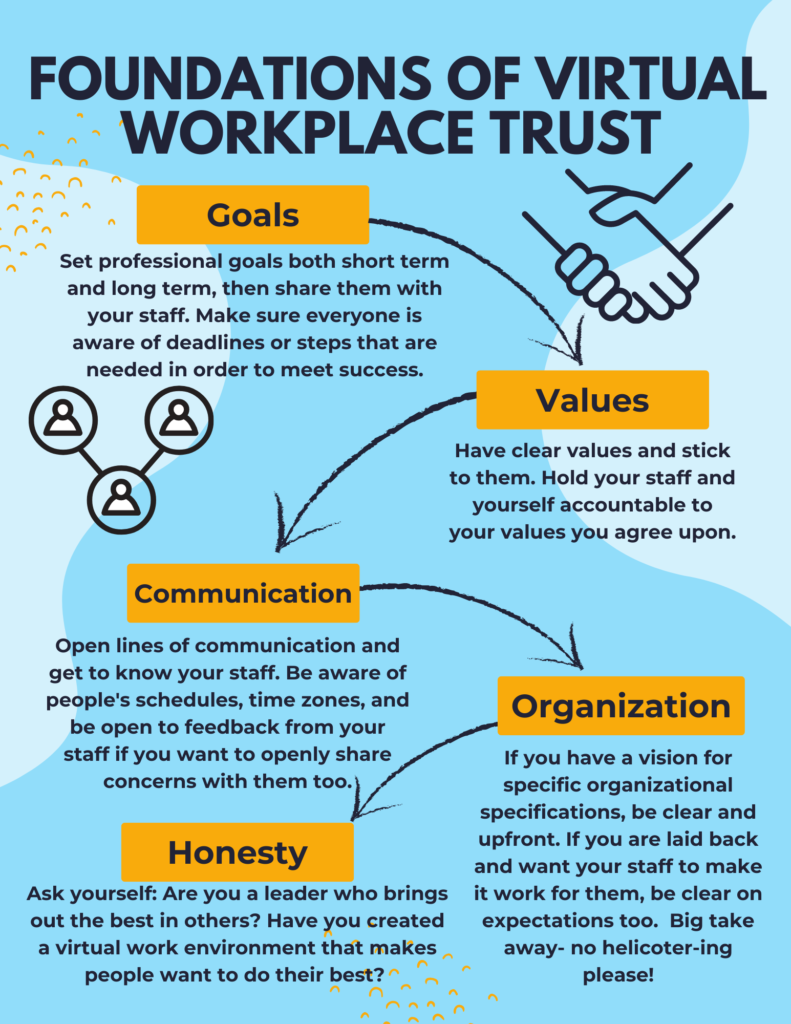Is It the Key to a Thriving Work Culture?

Indulge me in a short story: Do you remember “trust falls” from when you went to summer camp that one year way back when? I do. Except it wasn’t summer camp, I was at a sleepover. I also vividly remember being dropped flat on my back. Eventually, after much practice and giggles, we perfected our “trust fall” technique. Moral of the story is trust takes time and effort from everyone involved.
Creating trust in a virtual workspace is naturally more difficult than fostering trust in a physical workspace. Logistically speaking, trust requires a lot of effort from all parties involved. The Oxford Dictionary defines trust as “the firm belief of reliability, truth, ability, or strength of someone or something.”
Trust Can Be Tricky

In a traditional workspace like an office, your employees clock in on time or even early on a regular basis or you know that Carrie down in cubicle C3 brings in fresh-baked brownies when it’s someone’s birthday.
Trust has an innate sense of familiarity in terms of physically being with people. Forbes Magazine shared research from Boston College that determined cadence as being a significant factor. Cadence—or the ability to predict someone else’s behavior or reactions—can help foster a sense of trust because a lack of predictability is what can make people uneasy.
Take the physical workspace out of the equation and all of a sudden you are questioning if Joseph is actually waiting on a client to return a phone call like he said or if he is taking a long lunch this afternoon.
Maybe Glenda is overwhelmed with the new influx of clients and is having a hard time managing all her projects but she is afraid to speak up, so no one knows that she won’t make the deadline for a client now.
Not laying eyes on your employees and coworkers puts a new level of pressure on the trust you may have and that is totally understandable.
How to Build Trust Virtually
So, how do you create and build trust within a virtual space?
Let’s break down my top 5 components of workplace trust (from an employee’s point of view) and how to make sure you and your employees are on the right track to success.

#1 Goals
Your business, no matter the size or scale needs a clear goal and vision.
Are you solving a problem for a specific customer base? Do you provide some kind of product for any consumer?
Without a specific goal or goals, your business partners and employees will struggle. Your goal and mission statement should be at the center of what you do and it should also be shared by everyone who works with you, too. Passionate people who share similar goals will always bring out the best in themselves and others.
#2 Values
Likewise, you need clear values personally and professionally. Your staff should also have like-minded values too. This way, everyone is kind of on the same team so to speak. Integrity, empathy, and respect are notable and quite obvious. But, autonomy for example, the ability to push oneself independently with the “go-getter” attitude is important, especially working virtually.
For instance, micromanaging within a physical workspace can be bad enough, but virtually? Constant emails, phone calls, check-ins, wanting to be a part of every aspect of every part of someone’s tasks… that is exhausting and off-putting for staff. But is that reallllllllly what you envisioned when you took a leap of faith into your leadership role?
#3 Communication
Open communication has a few moving components in terms of a virtual workspace. One thing I have noticed in all kinds of relationships whether it is work-related, personal, anything–people tend to project onto others when we have been burned in the past.
Think of it this way, if you dated someone who cheated on you, your trust for someone else will inevitably go down and you may project your insecurities or feelings from the other person onto your new partner. Work-related– your last assistant was a lousy note-taker and a Forgetful Franny. So when you hire that new assistant, remember that Newbie Nancy isn’t Forgetful Franny and they deserve a clean slate.
Additionally, communication expectations need to be clear and a discussion should take place about some basics like staff meetings, emailing or phone call preferences, specific apps to download for chatting, etc. Below are 3 other components of communication worth taking a look at:
Time Zones
Virtual means you can hire someone 10,000 miles away which is quite a luxury if you ask me. But it doesn’t mean it is smooth sailing on its own. If you and your staff live in different time zones, do you want them to work at the same hours as you? If your workday starts at 8:00 EST, do you expect Susie who lives across the country to wake up for your 8:30 am staff meeting at 5:30 am PST? This is where open communication comes into play. For example, if an employee works in a different time zone, a few questions I would ask myself are:
- What time will ____ start and end their day?
- What time is convenient to have staff meetings so everyone can attend?
- How will ____ share updates on projects or completed tasks?
Trust looks different in different situations and even different people. In this case, trust means you have faith that your staff will continue to keep you in the loop despite having time differences.
Safe space to share
Did you ever have a teacher when you were in school or a friend growing up that was mad if you lied to them but equally mad if you told them the truth?
Being stuck between a rock and a hard place in terms of being honest and upfront with your boss is a really tricky place to be. If you want to avoid problems down the road and retain your staff, it may require you to take a step back and ask yourself if YOU would want to tell you that you made a mistake, for example.
A safe space to share in a virtual workplace might also include conversations about being overwhelmed or overworked, possibly feeling like someone doesn’t feel like an equal part of the team, or wanting to take on more responsibilities. Your staff wants to know that you’ve got their back because they’ve got yours. Most people don’t want to hurt the other person’s feelings but a safe space to discuss important topics that are uncomfortable means that your staff will respect you and come to you to talk even when they know it is hard.
That is a sign of a true leader!
Boundaries
Boundaries are important because everyone wants to feel heard and validated, especially in today’s society. Circling back to the time zones, being mindful of time and honoring other people’s time is really such a small act but has big rewards (unsolicited plug, but this job for example has deadlines and high expectations.)
Mary & Katie (co-founders of Virtually Yours Agency) make sure to be clear on expectations, ask for our feedback, and honor our time with punctual meetings and responses to messages. Respecting others’ boundaries is another way to build that trust. It shows your staff that you are a good listener, you are paying attention to them, that they are important, and you SEE them.
#4 Autonomy
Without organization, I think my entire existence would cease to continue on this beautiful planet.
But, not everyone is like that.
Being open to allowing your employee or business partner to work independently from you without being micromanaged will
1. Be beneficial to s/he and
2. Show another way to practice boundaries 😉. Autonomous employees are trusted employees. I
t may be that in order to build this working relationship with staff or even your business partner, you have to trust they will get the job done on time or to the expectations agreed upon. The other option is like hovering, I call it helicopter-ing; you let them do it on their own but you watch over them like a hawk to jump in if something goes wrong. If you hired them in the first place, they showed you they have the skills to pay the bills. Let them do their job!
#5 Honesty
No one likes to be lied to or feel like they are being deceived.
Period.
Communication goes hand in hand with honesty. People are sometimes dishonest due to a fear of communicating poor news. I can personally attest to this. (Remember when I mentioned cadence earlier? Well, no one wants to tell a “yeller” that you messed up… catch my drift?) Before you were the one in charge, I’m sure you were once an employee for someone else. In addition to this point, your employees can’t read your mind; your communication needs to come from both sides. Here is a little acronym to help you: H.O.T.
H- Humble
O- Open
T- Transparent
Final Takeaways
Whether you had a positive or negative experience, one of the things you probably remember is whether or not your old boss was open to honest feedback.
“I wish I could just tell so-and-so how I really feel,” is something plenty of people say all the time.
So as a leader, it is important to set the tone for your staff and a part of that is again, to take a step back. If dishonesty runs rampant throughout your staff… is it a staffing issue… or is it partly due to you or the leadership team?
It’s a hard pill to swallow for sure, no one likes to look in the mirror and realize they intimidate people or that they might be a part of the problem. That doesn’t mean you’re a terrible person. Quite the contrary actually, it means you reflected and you are open to being honest with yourself. That’s a big step in the right direction, don’t you think?
Virtual workspaces are taking over the business world right now and rightfully so. There are so many benefits and why not be at home if you can be just as productive and happy. But, making a virtual environment for trust can be a daunting task. If it wasn’t hard, it wouldn’t be rewarding.
Make sure to follow us at @virtuallyyoursagency.co for even more advice on how to thrive as a business owner!




View comments
+ Leave a comment